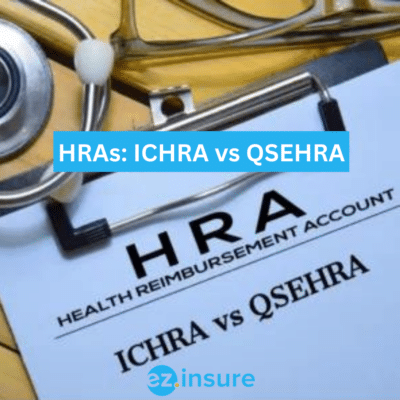
What are HRAs?
Before we get into these two types of HRAs let’s look at what a standard HRA is. A HRA might be the best way for a small business to help its workers get coverage at a price they can afford. HRAs are not health insurance plans. Instead, they are a way for employers to reimburse their workers for their health care costs that is allowed by the IRS. These are not accounts like HSAs or FSAs. Instead, they are agreements (hence the name), which makes them easier to use than bank accounts.
Employers don’t have to have a pre-funded account for distributing the money, but they can if they want. They keep the money until an employee files a claim for reimbursement. So, if an employee doesn’t ask for reimbursements or doesn’t ask for the full amount, the employer gets the money. On top of that, there are no taxes on the reimbursements!
What Are ICHRAs?
An ICHRA is a tax-free health benefit paid for by an employer that reimburses employees for their qualifying medical costs. With an ICHRA, employers give their workers a tax-free allowance each month to pay for certain medical costs. Employees then buy the health care services and things they want, like individual health insurance coverage, and the company reimburses them up to their allowance amount. Your employees can compare their options for individual coverage on the government health insurance marketplace.
There is no annual limit on how much an employer can contribute, and you can give different classes of workers different allowance amounts. There are two more things to keep in mind. First, employees and their families are only qualified for the ICHRA if they have coverage through a qualifying individual health insurance policy. If the employee or a family member who is part of the individual plan loses benefits, they can no longer get reimbursements.
Second, there are limits on the insurance tax credit in the ICHRA. Specifically, if an employee takes part in the ICHRA, they are no longer qualified for premium tax credits. Because of this, workers are free to opt out of the ICHRA as long as their allowance amount is considered “unaffordable” and wouldn’t provide minimum value under the ACA.
ICHRA Process
Here’s a step by step process for operating an ICHRA.
- You set the allowance – The amount of tax-free money you give to an employee for qualified costs is set by you. There can be different amounts for each type of employee. Such as full-time employees, part time employees, seasonal workers, etc. In general, ICHRA allowances for each class of workers should be the same. You can, however, give different allowances within that employee class based on the age of the worker or the size of their family.
- Employees receive healthcare – Employees pay for their own health care with their own money. They can buy the health goods and services that are right for them, such as individual health insurance.
- Employees submit proof – When an employee has a medical expense, they must show you proof. Such as a receipt or a letter from their insurance company explaining the services they received.
- You review – When an employee has a medical cost, they must show you proof. Like a receipt or a letter from their insurance company explaining the services they received.
- You reimburse the employee – The company pays back the worker up to the amount of their allowance. Both the business and its workers do not have to pay taxes on these reimbursements, but once the employee’s allowance limit is hit, they can’t get any more reimbursements.
Who Can Offer An ICHRA?
Even though ICHRAs are available to all organizations, a company can’t give both the ICHRA and a QSEHRA. You also can’t offer both an ICHRA and a group health plan to the same group of employees. For example, you could offer full-time employees a traditional group health plan and part-time employees an ICHRA, but you couldn’t give full-time employees an option between the group health plan and the ICHRA; it’s one or the other. ICHRAs are a good choice for businesses with 50 or more workers. Under the ACA’s employer mandate, you must give at least 95% of full-time employees health insurance that meets the minimum necessary coverage. Meaning they include the “10 essential benefits”.
What Is A QSEHRA?
A qualified small employer HRA (QSEHRA) is an official health benefit that has been approved by the IRS. It lets small businesses with fewer than 50 full-time employees pay their workers tax-free for their health insurance premiums and other health-related costs. With a QSEHRA, workers don’t have to sign up for a certain type of health insurance in order to be eligible. This gives them the freedom to choose any insurance plan they want.
Payroll taxes do not have to be paid on any QSEHRA reimbursements by you or your employees. If an employee has health insurance that offers minimum essential coverage (MEC), he or she may not have to pay income tax on reimbursements. Because these reimbursements are not taxed, workers don’t have to count their QSEHRA as income at the end of the year. Unlike traditional group health insurance, the QSEHRA doesn’t have minimum employer contribution limits. This means that you can give this benefit to your employees even if you don’t have a lot of money, but there are limits on how much you can give.
Also, there are no participation requirements to offer a QSEHRA. So you don’t have to have a certain number of workers registered in the benefit in order to offer it. Employers can set monthly budget caps with a QSEHRA, which gives them full control over their costs. Once the limits have been set, they can’t be broken. Also, because a QSEHRA doesn’t need to be pre-funded, costs are only paid out when an employee has a qualifying expense. Any money that isn’t used stays with you.
Who Can Offer a QSEHRA?
For your company to be qualified for the QSEHRA benefit, it must have fewer than 50 full-time employees. According to the Affordable Care Act, if you have 50 or more full-time employees, your company is a large employer. This means you can give an individual coverage HRA (ICHRA), but not a QSEHRA. In addition to having to be a certain size, an eligible employer cannot give a QSEHRA and any other group plan at the same time. If an employer wants a QSEHRA and already has a group health insurance policy, they can cancel it and become qualified.
Which Is Better For My Business?
If you want to use an ICHRA or a QSEHRA, you need to think about a few different things. You should start by thinking about your workers and what they need. Benefits are used by many employers as a way to keep good workers and attract new ones. Your benefits should be as personalized as possible to the people on your team. An ICHRA is likely your best choice if you want a more flexible health benefit. Such as more customization with employee classes, no limits on yearly contributions, or meeting the employer requirement.
But a QSEHRA is the way to go if you want a health benefit that is less expensive than group health insurance, easy to set up and run, and works for qualified small employers with less than 50 workers. No matter which HRA you choose, you’ll be picking a customizable health benefit that will give your workers more control over their own healthcare decisions while saving your company money.
Working With EZ
HRAs are a great way for employers to help their workers’ pay for medical costs they have to pay for on their own. Employers can keep costs down while giving their workers a perk that lets them pay for their own medical care. There are different kinds of HRAs, so most businesses will be able to find one that works for them. This is what makes HRAs so special and why they are becoming more and more popular. We’re also here to help if you need help figuring out the complicated world of insurance.
If you want to learn more about your choices for group insurance, you can get in touch with us at EZ. We’ll put you in touch with a highly trained person who can help you decide if an HRA is right for you and your business. You’ll save time, never have to deal with trouble, and never have to pay for our services. EZ.Insure will put you in touch with a specialized agent for free, so let’s get started! Put your zip code into the box below to get a price right away. Call 877-670-3531 to talk to your own agent.



 HRAs work through a reimbursement system. Employers offer employees a monthly allowance of tax-free money that they can use to pay for healthcare services, including health insurance, and then the employer reimburses them up to their allowance amount. But what if you’re a sole proprietor? You can offer this arrangement to any employees you have, but can you participate in the savings from an HRA yourself? In short, generally no, but there is a way you might be able to!
HRAs work through a reimbursement system. Employers offer employees a monthly allowance of tax-free money that they can use to pay for healthcare services, including health insurance, and then the employer reimburses them up to their allowance amount. But what if you’re a sole proprietor? You can offer this arrangement to any employees you have, but can you participate in the savings from an HRA yourself? In short, generally no, but there is a way you might be able to!
